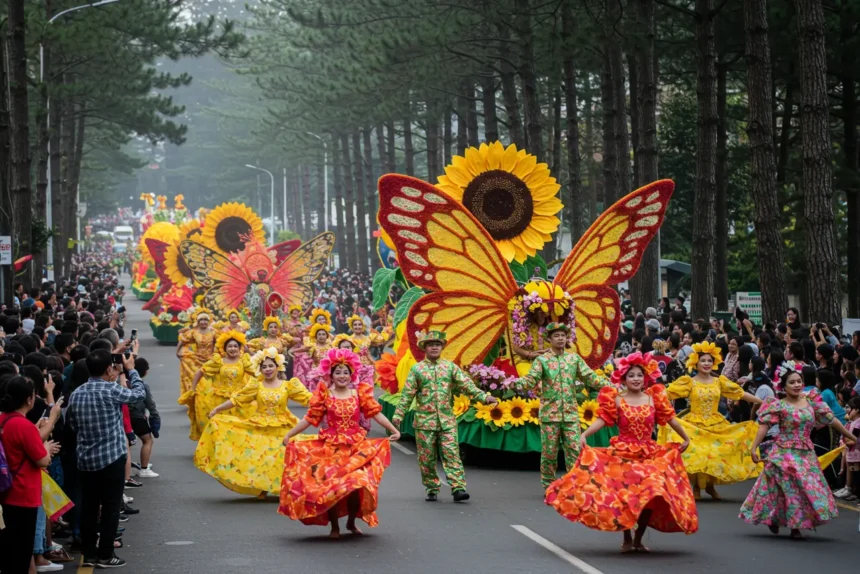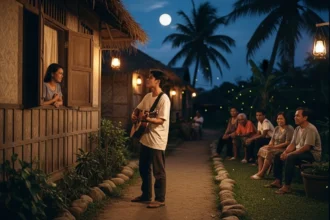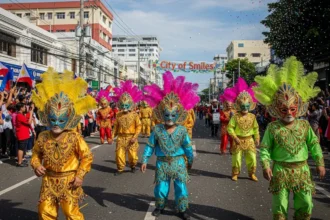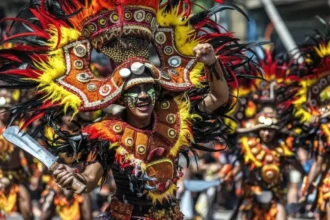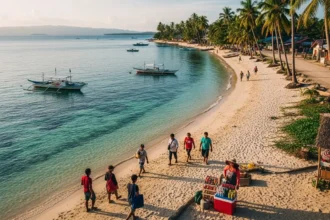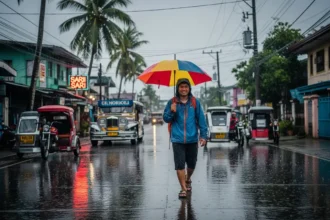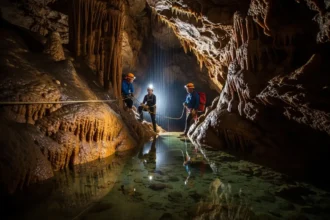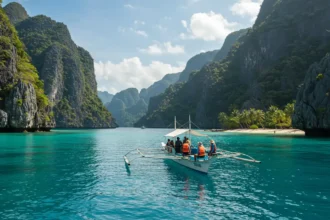Every February, Baguio bursts into a riot of color and blooms – it’s Panagbenga Festival season! From the grand street dance to the breathtaking float parade, this month-long celebration of flowers, culture, and community transforms the City of Pines into one giant fiesta.
If you’ve ever dreamed of seeing Baguio at its most festive (and most photogenic!), this guide will walk you through everything you need – the 2026 schedule, must-see parades and events, and insider tips on how to make the most of your trip without getting caught in the crowd. Tara, let’s experience the magic of Panagbenga together! 🌺
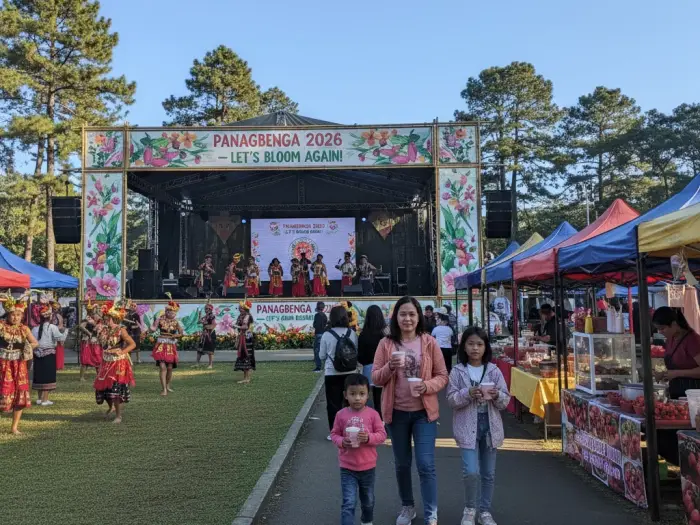
📅 2026 Schedule & Key Events
If you’re planning to experience Panagbenga Festival 2026, mark your calendars early – Baguio gets packed fast! The festival usually runs from the first week of February until the first Sunday of March, featuring a full month of parades, competitions, and cultural shows that bring the city alive.
While the official schedule from the Baguio Flower Festival Foundation, Inc. (BFFFI) is typically released around December or January, here’s a projected timeline based on the 2025 and 2024 editions – perfect for planning your trip ahead:
| Date (Tentative) | Event / Activity | What to Expect |
|---|---|---|
| Feb 1–2, 2026 | Opening Ceremony & Grand Launch | Kick-off celebration at Panagbenga Park with a mini float display, fireworks, and the first wave of street dancing. |
| Feb 8–9, 2026 | Panagbenga Cultural Dance Competition | Elementary and high school performers showcase traditional Cordilleran dance mixed with modern choreography. |
| Feb 15–16, 2026 | Barangay and Community Parade | Local barangays and groups join a friendly competition with creative costumes and floral designs. |
| Feb 22–23, 2026 | Grand Street Dance Parade 🥁 | The highlight! Thousands of dancers in flower-themed costumes fill Session Road and Harrison Road with energy, color, and beats. |
| Feb 29–Mar 1, 2026 | Grand Float Parade 🌸 | Iconic flower-covered floats parade down the streets – think of it as Baguio’s own version of the Rose Parade! |
| Mar 2–8, 2026 | Session Road in Bloom 🌼 | The city’s main road turns into a pedestrian shopping and food fair featuring local crafts, ukay finds, and Cordilleran dishes. |
| Mar 8, 2026 | Closing Ceremonies & Fireworks Display 🎆 | A dazzling fireworks show caps off the month-long festival, with live music and cultural performances at Melvin Jones Grandstand. |
💐 Pro Tip
If you’re aiming to catch both the Grand Street Dance and Float Parade, book your hotel at least two months in advance – the best spots near Session Road and Burnham Park fill up fast. Some locals even rent out balconies and rooftops for parade viewing, so ask around or check Facebook groups for listings.
🚨 Crowd & Traffic Reminder
Expect heavy traffic and limited parking throughout the festival weekends. Most roads around Burnham Park, Session Road, and South Drive are closed during parades, so it’s best to walk or use taxis. Jeepneys will have rerouted stops, so double-check before heading out.
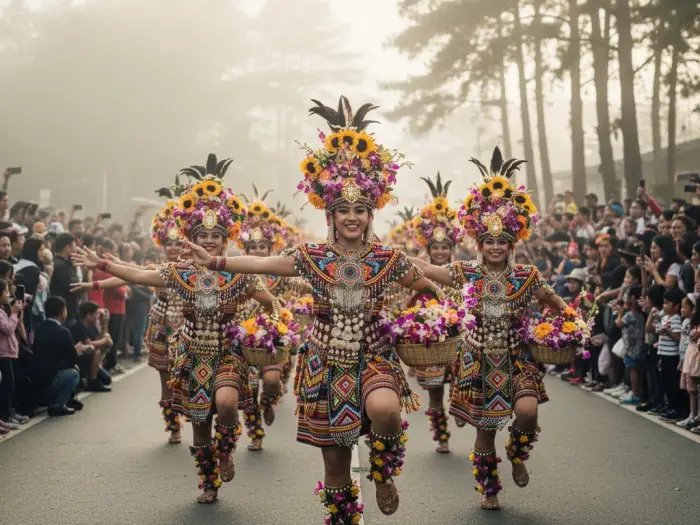
🎉 Parade Highlights & Festival Attractions
No part of the Panagbenga Festival 2026 is more anticipated than the parades – the heartbeat of Baguio’s most colorful celebration. Whether it’s the rhythmic street dancing or the jaw-dropping floats made entirely of flowers, these events capture the soul of the Cordilleras and the creativity of the Filipino people.
🥁 The Grand Street Dance Parade
If there’s one event you shouldn’t miss, it’s this one. The Grand Street Dance Parade turns the main roads of Session, Harrison, and Upper Session into a moving sea of color and rhythm.
Performers – from local schools, barangays, and cultural groups – wear vibrant costumes inspired by Cordilleran patterns, sunflowers, and native textiles. They dance to the beat of drums and native gongs, filling the air with pure energy.
Spectators line up as early as 6:00 AM to get the best viewing spots. The parade usually starts around 8:00 AM and lasts for several hours, so bring a hat, water, and patience – it’s worth every minute.
Quick Tips:
- Bring a foldable stool or mat if you plan to stay in one spot.
- Avoid umbrellas that block others’ view – use a cap or visor instead.
- Street vendors sell snacks like taho, corn on the cob, and strawberries with cream, perfect while waiting for the dancers to pass.
🌺 The Grand Float Parade
If the street dance celebrates movement, the Float Parade celebrates artistry. Huge floats made entirely of fresh flowers from Benguet – sunflowers, everlasting, roses, orchids, and more – roll through Session Road like moving gardens.
Each float is a masterpiece designed by artists, schools, and corporate sponsors, often featuring themes of love, nature, and Filipino pride. You’ll see kids’ favorites like anime characters, animals, and fairytale designs, all decked in blooms.
This parade usually takes place the day after the Street Dance Parade and attracts the biggest crowd of the festival.
| What You’ll See | Details |
|---|---|
| 🌼 Floral Floats | Intricately designed floats using thousands of flowers from La Trinidad and Baguio gardens. |
| 🎭 Costumed Mascots | Cheerful mascots and dancers accompanying floats for extra entertainment. |
| 📸 Photo Zones | After the parade, selected floats are displayed at Melvin Jones Grandstand for photo ops. |
| 🎤 Live Performances | Local artists, drumlines, and school bands perform between float intervals. |
Pro Tip:
If you’re not into crowded streets, catch the floats during their post-parade display at Burnham Park or Melvin Jones. Fewer crowds, same jaw-dropping visuals!
🌼 Session Road in Bloom
After the parades, Session Road transforms into a week-long street fair known as Session Road in Bloom – a must-visit for anyone who loves shopping, food, and local culture.
Imagine strolling along Baguio’s most famous street, closed off from vehicles, lined with:
- Food stalls offering Cordilleran dishes (pinikpikan, etag, strawberry taho)
- Local crafts and ukay-ukay treasures
- Live music and open-air performances every night
- Coffee stands and pasalubong stores perfect for souvenirs
It’s a vibe – chill, colorful, and proudly local. Best time to visit? Late afternoon, when the lights start to come on and the air gets cool.
🌙 Nighttime Attractions
Don’t pack up after sunset! Many hotels, cafés, and public areas host acoustic nights and street parties during festival weekends. The Baguio Athletic Bowl and Melvin Jones Grandstand often have live concerts and fireworks displays that light up the night sky.
You’ll feel that perfect mix of cool Baguio breeze, flower scents, and music in the air – a reminder why Panagbenga remains one of the most beloved festivals in the Philippines.
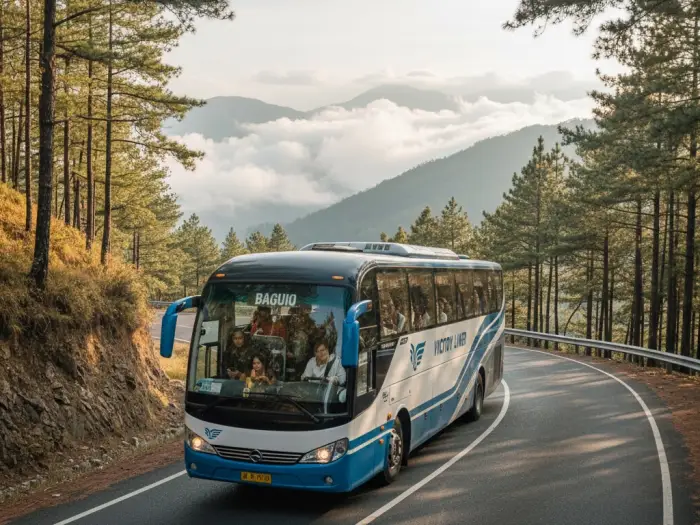
🧭 How to Get There & Travel Tips
Planning to join Panagbenga Festival 2026? Smart move – but timing and prep are everything. Because Baguio gets jam-packed during the festival, knowing the best routes, transport options, and local travel hacks can make or break your trip.
🚗 How to Go to Baguio
You’ve got plenty of options, depending on where you’re coming from:
| Mode of Travel | Estimated Travel Time | Details & Tips |
|---|---|---|
| 🚙 Private Car | 4–6 hours (from Manila) | Take TPLEX → SCTEX → NLEX route. Exit via Rosario, La Union, then continue up Marcos Highway (less fog, wider lanes). Avoid Kennon Road unless officially open. |
| 🚌 Bus | 4.5–6.5 hours | Victory Liner, Genesis JoyBus, and Solid North have daily trips from Cubao, Pasay, or PITX. JoyBus has a deluxe non-stop option with onboard comfort room. |
| 🛵 By Van or Carpool | 4–5 hours | Shared vans (P2P) run via app groups and terminals. Good for those traveling in small groups but book early. |
| ✈️ Nearest Airport | 1.5 hrs from Clark + 3 hrs land trip | You can fly to Clark International Airport, then take a P2P bus or van to Baguio. Great option for tourists arriving from Visayas or Mindanao. |
Pro Tip:
If you’re bringing a car, leave Manila by midnight to arrive in Baguio before sunrise – you’ll skip most of the traffic and still catch that misty morning vibe.
🏨 Where to Stay During Panagbenga
Hotels get fully booked fast, especially near Session Road and Burnham Park. Reserve as early as December if you want central accommodation.
| Location | Recommended For | Budget Range (per night) |
|---|---|---|
| Session Road / Burnham Park | Best access to parades & nightlife | ₱3,000–₱6,000 |
| Mines View / Outlook Drive | Quiet scenic views | ₱2,000–₱4,500 |
| Camp John Hay area | Mid to high-end stays, peaceful surroundings | ₱5,000–₱10,000 |
| La Trinidad / outskirts | Budget stays, fewer crowds | ₱1,200–₱2,500 |
Local Hack:
If hotels are fully booked, try Airbnb cabins or transient houses in La Trinidad – just 20 minutes away and much easier to park.
🕒 When to Visit
While Panagbenga runs the whole month, the main events (Street Dance & Float Parades) are usually on the last two weekends of February.
- Best time to arrive: A day before the parades (Friday)
- Best time to leave: Monday morning – avoid the Sunday night bus rush
- Best weather: Early morning (6–9 AM) for parades; evenings are chilly at 14–17°C so bring a jacket.
🎒 What to Pack
Panagbenga might be a “flower festival,” but trust us – it’s a survival game if you’re not prepared.
✅ Essentials to pack:
- Light jacket or hoodie (Baguio nights can get cold)
- Cap or visor for parade days
- Power bank and water bottle
- Snacks (lines can be long during parades)
- Cash (some stalls don’t accept GCash or card)
- Small foldable stool or picnic mat
- Camera or phone with lots of storage – trust us, you’ll take hundreds of shots
🧠 Smart Travel Tips from Locals
💡 Avoid driving into the city center during parade days. Park near Teacher’s Camp or Burnham Park Extension, then walk.
💡 Eat early or late. Restaurants get jam-packed at lunchtime. Try odd hours (10 AM or 3 PM).
💡 Stay connected. Baguio has good LTE coverage, but load your GCash early – WiFi gets spotty during events.
💡 Respect local culture. Avoid blocking performers or entering parade routes for selfies.
🚌 Mini Itinerary Example (3D2N Panagbenga Trip)
| Day | Activity Plan |
|---|---|
| Day 1 (Fri) | Early morning travel from Manila → Check-in → Explore Burnham Park and Session Road → Try Café by the Ruins for dinner. |
| Day 2 (Sat) | Watch Grand Street Dance Parade → Lunch at Good Taste → Afternoon coffee at Camp John Hay → Night stroll at Session Road in Bloom. |
| Day 3 (Sun) | Watch Float Parade → Visit Botanical Garden or Mines View → Buy pasalubong (strawberry jam, ube, coffee) → Travel back to Manila by 5 PM. |
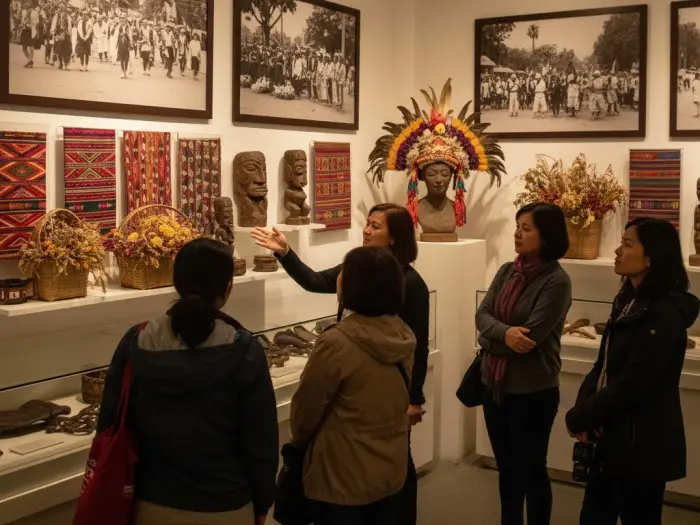
🌺 Panagbenga History & Cultural Significance
Before the floats, confetti, and TikTok dances, Panagbenga was born from something much deeper – healing and hope.
The word “Panagbenga” comes from the Kankanaey term meaning “season of blooming.” The festival began in 1995, when Baguio was still recovering from the devastation of the 1990 Luzon earthquake. The idea was to lift the city’s spirits, honor its natural beauty, and showcase the resilience of its people through art, music, and flowers.
🌸 The Birth of a Tradition
It was the late Atty. Damaso Bangaoet Jr. who first proposed the idea to the Baguio Flower Festival Foundation. The goal? To create an annual celebration that would:
- Highlight the floral wealth of the Cordilleras
- Attract local and foreign tourists to help revive Baguio’s economy
- Celebrate indigenous culture and traditions
The first Panagbenga in 1996 was modest – just a few school performances and community parades. But the warmth of the locals and the stunning flower displays quickly caught national attention. Fast forward to today, and Panagbenga has become one of the Philippines’ grandest and most anticipated festivals, drawing over a million visitors every year.
🌼 A Tribute to Cordilleran Heritage
At its heart, Panagbenga honors the Cordilleran tribes – particularly the Ibaloi, Kankanaey, and Ifugao peoples – whose relationship with the land and nature runs deep. The rhythmic dances mimic the movements of planting, harvesting, and celebrating abundance, all performed to the beat of native gongs and drums.
Many parade costumes feature woven textiles from local weavers, showcasing not just beauty but identity. Every color and pattern tells a story – of mountains, rivers, and traditions passed down through generations.
“It’s not just a festival of flowers. It’s a festival of people – of stories, of survival, and of pride,” says one local performer who’s danced in the parade since childhood.
🌻 The Flowers That Built the Festival
What makes Panagbenga uniquely “Baguio” are the flowers themselves – bright, fresh, and proudly local.
Benguet’s farms supply most of the blooms used for the floats and decorations, including:
| Flower Type | Symbolism | Common Uses |
|---|---|---|
| 🌼 Sunflower | Happiness, resilience | Parade floats & city décor |
| 🌸 Everlasting | Eternal love | Traditional garlands, costume trims |
| 🌹 Roses | Beauty and passion | Float artistry |
| 🌻 Chrysanthemums | Renewal and optimism | Street designs & dance props |
| 🌷 Orchids | Elegance and grace | Stage decorations & VIP floats |
Each bloom reflects a piece of Cordillera’s spirit – vibrant, enduring, and full of life.
🌈 Panagbenga Today
From a local event to a national tourism icon, Panagbenga has evolved without losing its roots. The festival now serves as a platform for:
- Environmental awareness, encouraging sustainable floral use and recycling parade materials
- Youth creativity, through competitions, art fairs, and school performances
- Economic growth, supporting local farmers, hotels, and artisans
Even with its modern touches – influencers, drones, and TV coverage – Panagbenga remains a heartfelt tribute to Baguio’s soul: a city that blooms no matter the season. 🌸
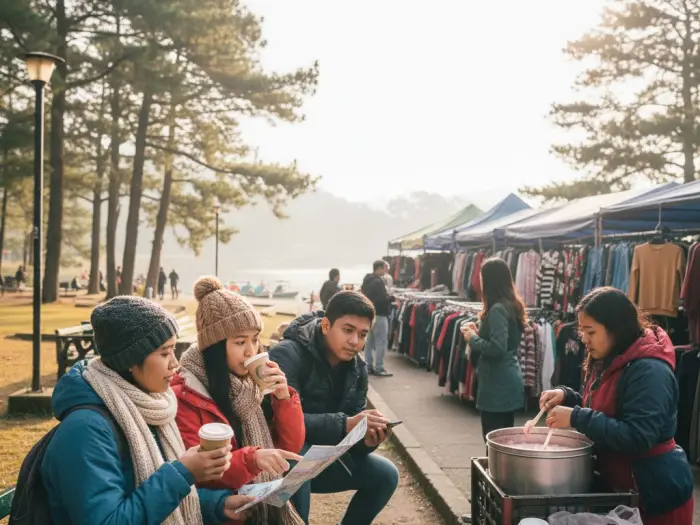
💡 Travel Hacks & Local Tips for First-Timers
If it’s your first time attending Panagbenga Festival 2026, welcome to organized chaos – in the best way possible. Baguio transforms into a city-wide fiesta, so expect energy, crowds, colors, and a few surprises along the way. Here’s how to make your experience smooth, fun, and budget-friendly.
🕕 1. Arrive Early (Like, Really Early)
If you want a good parade spot, arrive by 6:00 AM. Locals claim their viewing areas before sunrise – some even bring chairs and blankets. The streets get crowded fast, especially near Session Road, Harrison Road, and Burnham Park.
Pro Tip: Stay in a hotel or Airbnb within walking distance of Session Road. That way, you can just step out and catch the parade without worrying about parking or road closures.
📸 2. Find the Best Photo Spots
| Location | Why It’s Great |
|---|---|
| Session Road (near SM Baguio) | Overhead view of floats and dancers |
| Melvin Jones Grandstand | Where floats pause for exhibitions and performances |
| Burnham Park corners | Beautiful backdrop with trees and open sky |
| Upper Session Road / Cathedral Hill | Great for wide-angle shots of the parade flow |
Don’t forget to bring extra storage for photos – you’ll take hundreds!
🪙 3. Manage Your Budget Wisely
You can still enjoy Panagbenga on a ₱3,000–₱5,000 weekend budget if you plan right. Here’s a sample breakdown:
| Expense | Estimated Cost (3D2N) |
|---|---|
| Bus (RT from Manila) | ₱1,200–₱1,600 |
| Lodging (budget inn / transient) | ₱1,000–₱1,500 per night |
| Food & snacks | ₱700–₱1,000 |
| Souvenirs & pasalubong | ₱500 |
| Miscellaneous (Grab, entrance fees) | ₱500 |
💡 Tipid Hack: Skip hotel breakfast and eat at local carinderias – you’ll get full meals for ₱80–₱120. And don’t miss Good Taste Restaurant, a Baguio icon known for huge servings and small prices.
🚶 4. Go Car-Free
During parade weekends, most main roads are closed to private vehicles. Parking is nearly impossible near Burnham Park and Session Road. Your best bet? Walk or ride a taxi/jeepney to designated drop-off points.
If you really must drive, park outside the city center – try Teacher’s Camp, Baguio Convention Center, or Slaughter Compound area – then walk.
🌤️ 5. Dress for the Weather
Remember: Baguio weather can be tricky. Mornings are warm under the sun, but afternoons can turn foggy and cold.
✅ What to wear:
- Light layers (shirt + hoodie or jacket)
- Comfortable shoes (you’ll walk a lot)
- Cap or visor (no umbrellas – they block views!)
🍓 6. Try the Local Eats & Drinks
Don’t leave without tasting these Baguio staples:
- 🍓 Strawberry taho – sweet, warm, and iconic
- 🥗 Pinikpikan – traditional Cordilleran chicken dish
- 🧀 Ube jam from Good Shepherd Convent
- ☕ Baguio coffee – locally roasted and perfect for cold mornings
- 🥐 Vizco’s strawberry shortcake – tourist favorite!
If you’re craving something light during parades, street food stalls sell grilled corn, ukoy, fish balls, and sweet potatoes – great for snacking while watching.
🔋 7. Stay Connected & Safe
- Bring a power bank and load your GCash early – internet can slow down when the city is packed.
- Keep your valuables close and zipped; use a small sling bag or fanny pack.
- Always follow marshals’ instructions – especially when crossing or taking photos during parades.
💬 8. Mingle with Locals
The best part of Panagbenga isn’t just the floats – it’s the people. Baguio folks are friendly and proud of their city’s heritage. Strike up conversations with stall owners, performers, or students. You might even discover hidden food spots or secret viewing areas only locals know.
🌙 9. Extend Your Stay (If You Can)
After the festival weekend, Baguio goes back to its calm, misty self. That’s when you can really explore places like:
- Camp John Hay for quiet coffee mornings
- BenCab Museum for art and mountain views
- La Trinidad Strawberry Farm for picking fresh berries
- Tam-awan Village for Cordilleran culture and crafts
You’ll see a different, more peaceful side of the city after the crowds are gone.
❤️ 10. Leave No Trace
Lastly – and this one matters – don’t leave trash behind.
Panagbenga may be about flowers and festivities, but it’s also a reminder to honor nature and the beauty of Baguio. Bring your own water tumbler, reuse utensils, and clean up before leaving. Small acts, big impact. 🌿
❓ FAQs About Panagbenga Festival 2026
1. When is the Panagbenga Festival 2026 in Baguio?
Panagbenga Festival 2026 is expected to run from February 1 to March 8, 2026, with the Grand Street Dance Parade on February 22 and the Grand Float Parade on February 23. The official schedule will be confirmed by the Baguio Flower Festival Foundation, Inc. (BFFFI) closer to the event.
2. What does “Panagbenga” mean?
“Panagbenga” comes from the Kankanaey word meaning “season of blooming.” It celebrates Baguio’s floral heritage and the resilience of its people after the 1990 Luzon earthquake.
3. Where are the main Panagbenga parades held?
The street dance and float parades usually pass through Session Road, Harrison Road, and end at Melvin Jones Grandstand inside Burnham Park, where performances and judging take place.
4. How early should I arrive to watch the parade?
If you want a good spot, be there by 6:00 AM. The parades start around 8:00 AM, but Session Road fills up early with both locals and tourists claiming prime viewing areas.
5. What should I wear during Panagbenga Festival?
Baguio weather is chilly in February, so wear layers – a shirt, jacket, and comfortable shoes. Bring a cap or visor for the morning sun and a hoodie for the cold evening breeze.
6. Is there an entrance fee for the Panagbenga Festival?
No, all parades and public events are free. However, you’ll need to budget for transport, food, and accommodation since hotel prices usually rise during the festival season.
7. What’s the best way to travel to Baguio for Panagbenga?
From Manila, you can take a Victory Liner, JoyBus, or Solid North bus from Cubao or Pasay (4–6 hours travel time). For private cars, the TPLEX–SCTEX–NLEX route via Marcos Highway is the most convenient and safest.
8. What are the top attractions during Panagbenga aside from the parades?
Don’t miss Session Road in Bloom, where the city’s main road turns into a week-long street fair with food stalls, live music, and local crafts. You can also visit Mines View Park, Burnham Park, and Tam-awan Village after the festivities.
9. Are there safety or crowd tips I should know?
Yes – expect huge crowds. Keep your belongings secure, follow designated walking routes, and avoid blocking parade routes for selfies. Bring water and light snacks to stay hydrated while waiting.
10. What local food should I try during the festival?
Try strawberry taho, Good Taste’s fried rice and buttered chicken, pinikpikan, and Vizco’s strawberry shortcake. These local favorites complete the Baguio experience while enjoying the festival vibe.
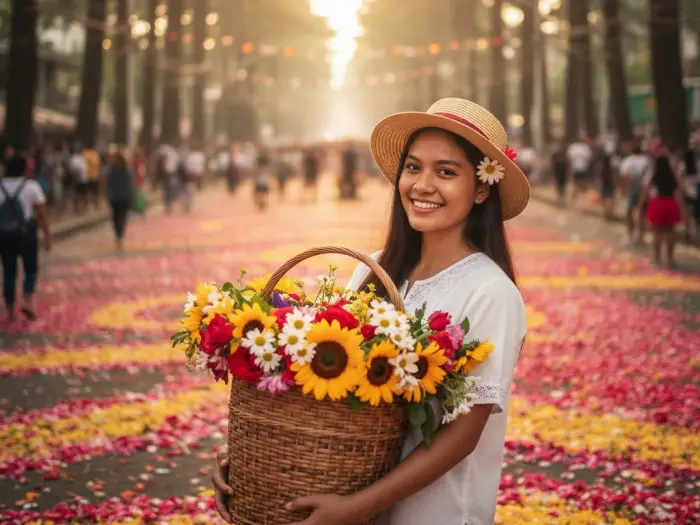
🌸 Ready to Bloom with Baguio?
If there’s one thing the Panagbenga Festival 2026 teaches every visitor, it’s this – no matter how tough the season, there’s always a time to bloom. 🌼
From the rhythmic beats of the Grand Street Dance Parade to the breathtaking colors of the Float Parade, every moment in Baguio during Panagbenga feels alive with hope and community. It’s not just about the flowers – it’s about celebrating life, resilience, and Filipino creativity at its finest.
So if you’ve been meaning to tick this off your bucket list, start planning early.
Book your stay, pack your jacket, and bring that camera – because this isn’t just another trip. It’s an experience that will make you fall in love with Baguio all over again.
Take it from every traveler who’s been there: once you see the city in full bloom, you’ll understand why Panagbenga isn’t just a festival – it’s a feeling. 💖
🧭 References
- Wikipedia – Panagbenga Festival
- Official Panagbenga Website – Panagbenga® – The Baguio Flower Festival
- Camella Homes Blog – The Colorful History of the Panagbenga Festival
- Philippine Information Agency (PIA) – Panagbenga Features and News
- TravelPhilippines.fun – The Panagbenga Festival: A Season of Blooming and Joy



